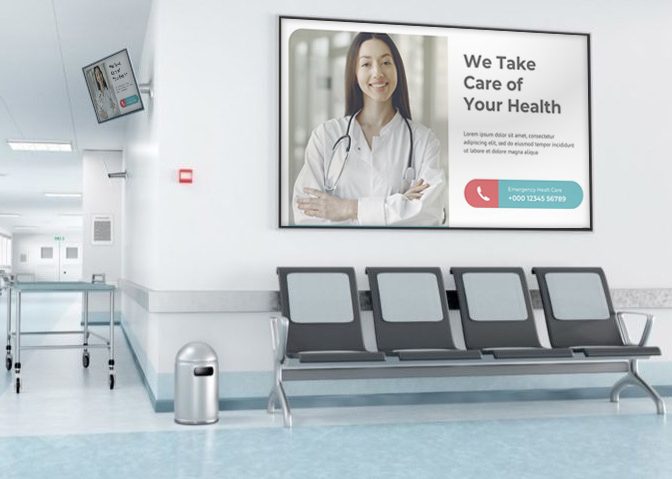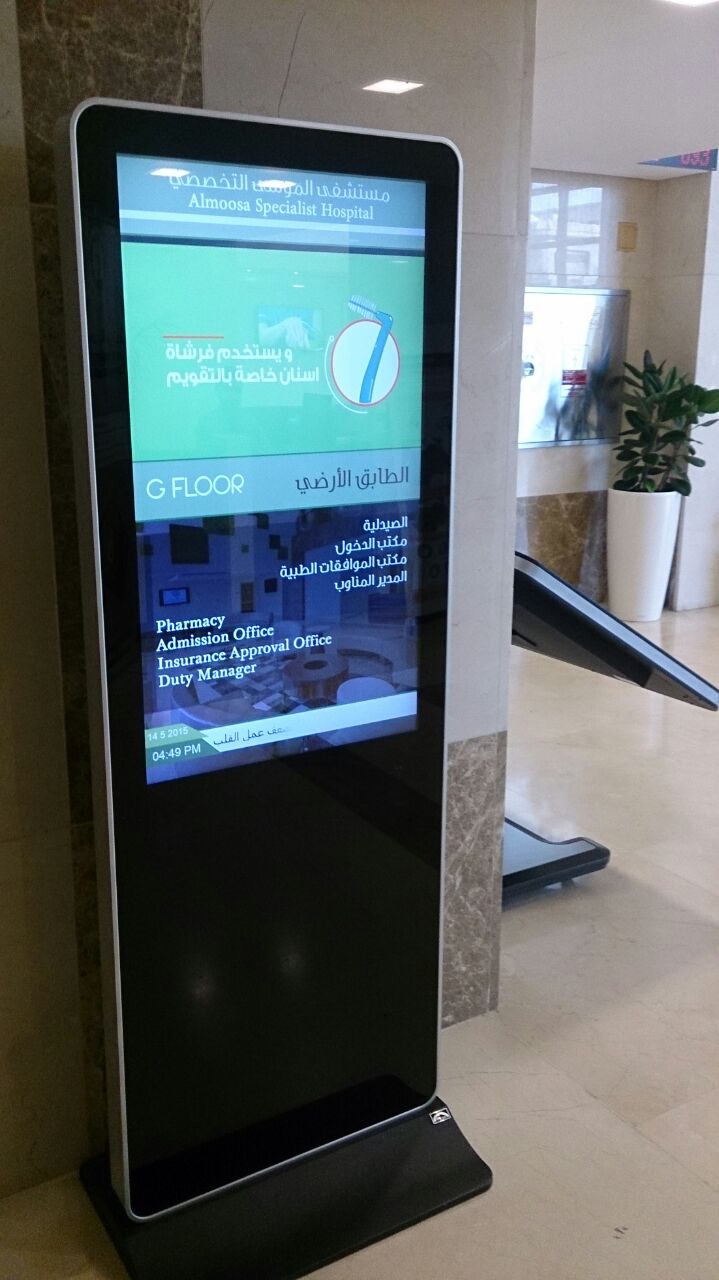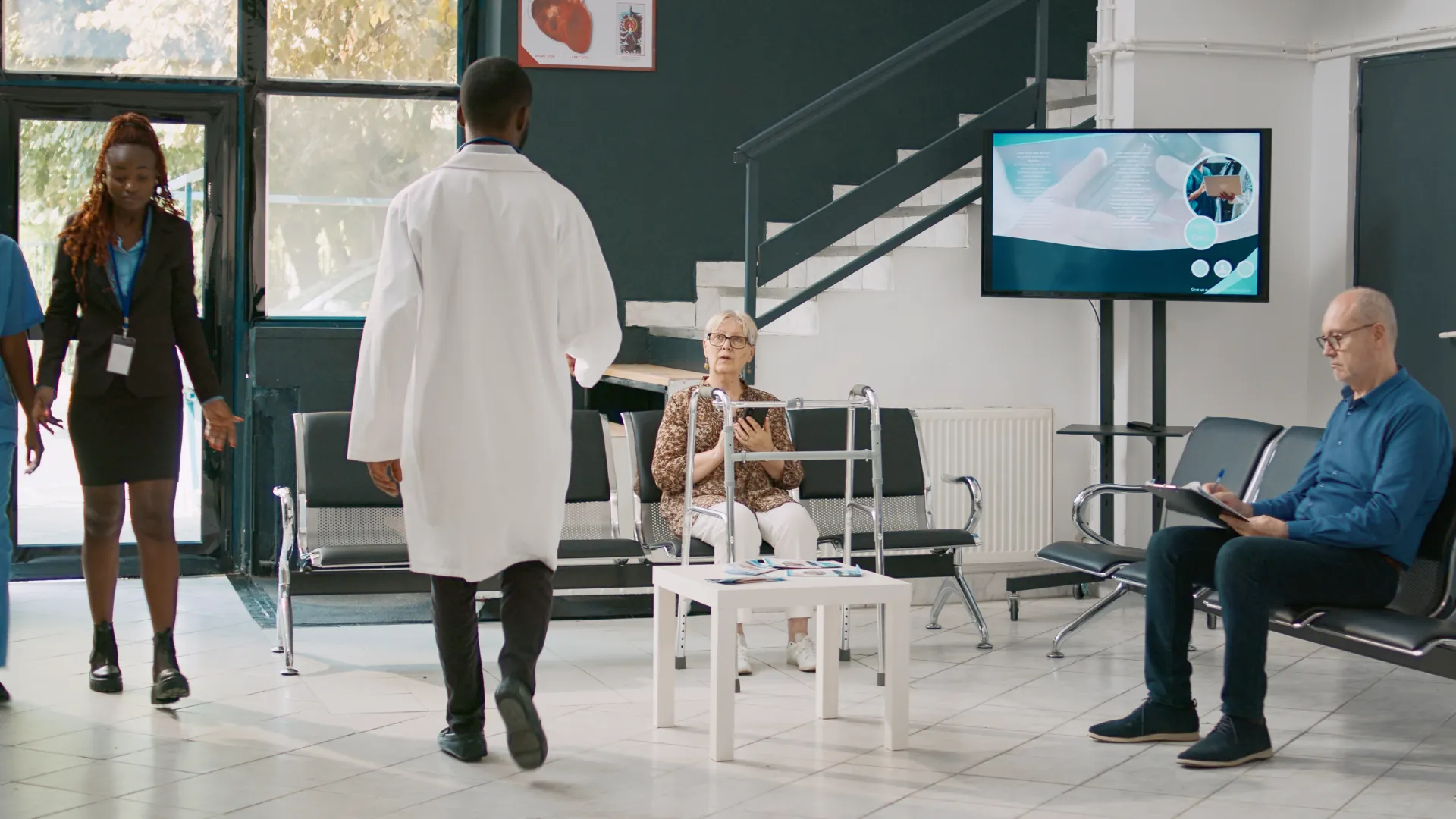Streamline Hospital Patient Care
and Communication With Visitors
Why do healthcare use digital signage?
Hospitals use digital signage as an efficient communication tool, disseminating crucial information like visiting hours, patient instructions, booking schedules and medical event announcements in a clear and timely manner. It improves patient and staff education by raising awareness on health topics, disease prevention, and best hygiene practices. Additionally, digital signage assists in wayfinding within the hospital premises, offering interactive maps and departmental directions for patients and visitors. By displaying estimated wait times, it helps manage patient expectations and reduce anxiety. Lastly, it facilitates the promotion of hospital services, showcasing health programs, specialized clinics, and other offerings.
Furthermore, healthcare providers must ensure the health and well-being of everyone who spends time on hospital premises. Hence, the larger the facility, the more complex the challenge. It’s an important role and one that is increasingly fulfilled by hospital digital signage.
Communication through screens with a digital signage CMS software that combines automated real-time content, the ability for employees to interact with the displayed content from their mobile device, or a user-friendly CMS interface becomes crucial in the choice of hospitals
Here are a few examples where hospital digital signage is making a difference.
Hospital digital signage for donor recognition walls
For years, hospitals have utilized donor recognition walls, but now digital signage is ushering these walls into the modern age. Hospital administrators can acknowledge donors using various visual presentation options through digital signage-powered donor walls. By combining static images, videos, and animations, they create attention-grabbing visual content to honor donors and recognize hospital staff.
Moreover, digital donor walls can be either passive or interactive. Choosing interactivity enhances the overall experience, making it more memorable for a long time. Individuals can navigate the wall and learn about milestones in medical research and technology at their own pace through interactive content.
Hospital staff information signage
Internal communications are critical to a hospital’s operation. It’s why hospital digital signage plays such an important role in keeping staff informed and motivated throughout the day.
Hospital digital signage is commonly used in staff meeting rooms where it provides an ideal platform for employee communications. Surely, screens installed in meeting rooms can also provide essential employee support for seminars and other group functions.
Hospital digital signage located in private areas can be programmed to show empowering, engaging, and motivational content to staff members. Meanwhile, lunchroom screens screen today’s healthy menu choices and daily specials to staff and visitors alike

Hospital lobby messaging
Lobby message screens welcome patients and visitors 24/7. These digital screens deliver a mix of infotainment and news to help reduce perceived wait times. This is one of many opportunities for hospitals to deliver a better visitor experience.
Hospital digital signage can also assist in guiding individuals to specific areas, such as meeting with a triage specialist in an emergency room or clinic. To provide these services, digital screens are connected to queue management systems and other hospital software applications. This integration guarantees that patients are directed to the next available resource promptly when they are prepared.
Healthcare clinics can benefit from hospital digital signage screens as they can personalize content for returning patients.
Depending on the specialty (cosmetic surgery, dentistry, eye care, etc…), digital signage content can be educational.
Hospital lobby screens can be programmed to show videos that explain…
- Medical procedures
- Healthy eating tips and guidelines
- Medical news and innovations
- Drug information
- …and many other important topics
Patient care areas
Hospital staff regularly use digital screens in common areas to keep in touch with patients. These screens serve as a way to share important information like announcements, notices, warnings, and real-time updates. Additionally, the hospital’s cable TV system directly sends this information to each patient’s room, making sure everyone gets it.
By using digital content on the screens, the hospital can interrupt regular programs and get the attention of viewers effectively. After delivering the message, the regular programs automatically come back without needing anyone to do it manually. The hospital content smoothly blends with live TV broadcasts or other content types like RSS, Media RSS, social media feeds, and live information sources.
Following these suggestions can greatly improve patient morale, as they receive thoughtful and valuable content throughout their hospital stay.

Hospital wayfinding
Digital signage has emerged as one of the most useful platforms for wayfinding.
Anyone who has had to find their way around a large, unfamiliar hospital knows it can be a frustrating experience. Traditional wayfinding signage can be confusing at times, and difficult to decipher. It’s even worse when a healthcare facility spans multiple buildings.
Wayfinding screens can be used near:
- Emergency rooms
- Urgent care clinic lobbies
- Hospital welcome centers
- Rehabilitation centers
- Pediatrics departments
- Radiology
- …in fact, every public area can benefit from wayfinding screens.
A properly designed wayfinding map will provide useful information such as the person’s current location, emergency exits, stairways, and elevators. Wayfinding content can include QR Codes that visitors can scan to download a copy of the site map on their smartphones. Frequent visitors may also be able to download a dedicated wayfinding app on their smartphones. These apps can interact with screens and provide additional information for visitors.
Benefits include:
- Easier access to the entire healthcare facility
- A better visitor experience
- Fewer resources are required at information desks
- Less distraction for healthcare personnel
Advantages of digital signage for hospitals
Modern digital signage solutions have all but eliminated complex software configurations and repetitive maintenance tasks. Deploying digital signage today is as easy as entering an activation code on a System on Chip (Smart) screen. With these new technologies, there are no external hardware components to install and no exposed wires hanging behind the screen. And since the standalone player is contained inside the screen’s frame, there are fewer chances for tampering or theft.
Today’s digital signage products can be deployed within minutes, with minimal technical skills.
Enhanced network security
Security has always been a top priority for healthcare providers. Every year, hospitals spend huge sums of money to secure their networks and protect patient data. The best hospital digital signage solutions support modern network security features and proxy servers to ensure hospital networks are protected from attacks.
Lower maintenance costs
In the past, early digital signage software required a lot of manual work, with staff doing each task one by one. But things have changed in hospital digital signage. Now, there are many software options that can automate repetitive tasks using rules.
For example, staff can load content in advance and set it to appear on specific days or in the future. Some products even allow content to play only in certain locations. These advanced solutions use rules to control when and where the content is shown.
Some products also have software development kits (SDKs) that let technical staff connect the digital signage software with the hospital’s internal systems and databases. This way, content updates and management tasks can happen automatically, so the staff can focus on other important things.
Looking to the future
As technology improves, we see more SoC screens coming to market with higher resolutions and increased image quality. Other standalone player hardware (PCs, Android devices) will continue to evolve and provide better performance in smaller devices.
Digital signage has a bright future in healthcare services.
